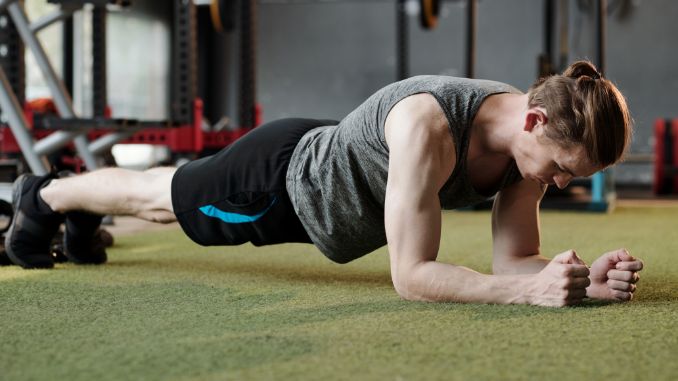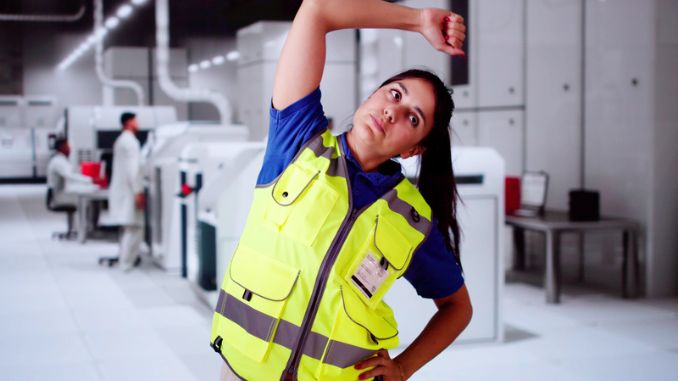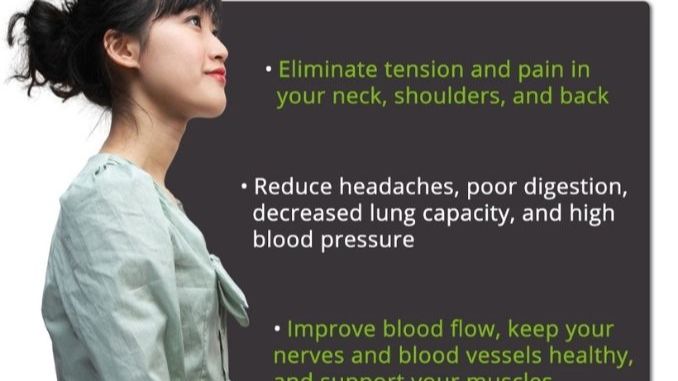If you've ever noticed your rib cage [²] sticking out more than it should, especially when lying flat, you might be experiencing flared ribs.
At first, it might seem like just a small quirk, but I’ve come to understand that this issue can do more than just change how you look—it can throw off your spinal alignment, mess with your breathing, and even lead to lingering pain if left unchecked.
Flared ribs typically happen because of muscle imbalances or poor posture, and understanding what they are and how they impact your body is essential for keeping up good posture and overall well-being.
When I first came across this issue, I was surprised to learn how much it could influence everyday activities, from working out to something as simple as breathing deeply.
The good news is that flared ribs can often be corrected with targeted exercises and stretches.
In this guide, we’ll look at the common causes behind rib flare and review the symptoms to watch.
But more importantly, I'll walk you through routines that can help pull things back into alignment.
Whether your goal is to improve your posture, strengthen your core, or feel more comfortable in your body, these tips can make a difference.
So, if you’re ready to tackle this and start feeling better, let’s dive in.
Understanding Flared Ribs
Flared ribs happen when the lower part of the rib cage sticks out due to muscle imbalances or poor posture.
Known as 'rib flaring,' it's most noticeable when lying flat, as the ribs protrude instead of aligning with the body.
While it might seem like just a cosmetic issue, flared ribs can lead to postural problems and even chronic pain if left unchecked.
Anatomy of the Rib Cage and Core Muscles

The rib cage is essential for protecting vital organs and supporting proper breathing. It is connected to core muscles like the diaphragm [¹] and abdominal muscles, which help maintain spinal alignment. When these muscles are weak, especially weak core muscles, the rib cage can shift, leading to flared ribs.
Additionally, issues with the thoracic spine or pelvic tilt can cause the rib cage to flare outward, disrupting breathing and potentially leading to chronic pain.
Performing the bird dog exercise, which involves extending one leg back while keeping the opposite arm parallel to the ground, helps improve stability and rib cage alignment.
Common Symptoms and Signs
For me, the most obvious sign of flared ribs is when the lower part of the rib cage noticeably sticks out, especially when lying down or raising my arms overhead, which seems to exaggerate the flare.
But beyond how it looks, there are other symptoms I’ve noticed.
Poor posture is a big one. Flared ribs often have muscle imbalances that cause a forward head position or a rounded upper back.
I’ve also found that rib misalignment can make deep breathing harder, interfering with how the diaphragm works.
If you’ve ever struggled to take a deep breath, your rib positioning could be the reason.
Over time, I’ve heard others mention dealing with chronic pain, especially in the lower or mid-back, which can be uncomfortable around the lumbar or thoracic spine.
Recognizing these symptoms is a key first step. In the next sections, I’ll dive into what causes flared ribs and, most importantly, how you can fix them with some targeted exercises and stretches.
Causes of Flared Ribs

Muscle Imbalance
Flared ribs are often due to muscle imbalances in the core, especially weak abdominal muscles and the diaphragm. This weakness allows the rib cage to shift out of alignment, while tight lower back muscles can worsen the issue. Targeted exercises and physical therapy are needed to strengthen the core and correct these imbalances.
Poor Posture

Poor posture—such as slouching or rounded shoulders—contributes to flared ribs by causing excessive curvature in the thoracic spine and misaligning the rib cage.
An anterior pelvic tilt can make the condition worse. Sedentary lifestyles often lead to these postural problems.
Injuries or Previous Conditions
Past injuries or conditions affecting the thoracic or lumbar spine can misalign the rib cage, leading to flared ribs.
These injuries can create compensatory movement patterns that exacerbate muscle imbalances.
Conditions like scoliosis, which alters spinal alignment, can also cause the lower ribs to protrude, leading to further misalignment.
The Impact of Flared Ribs on Health

1. Postural Complications
From what I’ve experienced, flared ribs can seriously impact posture, leading to abnormal spinal alignment and pelvic instability.
When this happens, it often creates a forward head posture or a rounded upper back, which puts extra stress on the thoracic and lumbar spine.
I’ve found that an anterior pelvic tilt can make things even worse, limiting mobility and making it tough to maintain a neutral posture.
This can result in ongoing discomfort and functional limitations.
2. Breathing Mechanics
Another big issue with flared ribs is how they affect breathing. With the ribs flaring outward, the diaphragm can’t function as efficiently, causing shallow and ineffective breathing.
I’ve learned that this misalignment can decrease oxygen intake, increase stress on the body, and even contribute to anxiety and fatigue over time.
Addressing flared ribs can help restore healthier breathing patterns and support better respiratory health.
3. Chronic Pain and Discomfort
Chronic pain is another common result of flared ribs. The strain on the thoracic and lumbar spine and muscle imbalances often lead to tightness in surrounding muscles like the lower back and hip flexors.
This persistent pain can interfere with daily activities, reduce physical activity, and diminish overall quality of life, which can be incredibly frustrating.
How to Fix Rib Flare: Rib Flare Exercises

1. Rib Flare Exercise Routine
When correcting flared ribs, I’ve found that a targeted routine focused on specific exercises, core strengthening, and improving posture is essential. Here’s what’s worked for me.
2. Core Strengthening
To stabilize the rib cage and fix muscle imbalances, I rely on exercises like:
Planks
Dead Bugs
Bird Dog
Pelvic Tilts
These moves help me support my spinal alignment and keep my ribs in place.
3. Stretching Exercises
Flexibility is key, especially in the thoracic spine and hips. For this, I incorporate:
Thoracic Spine Mobility Drills
Hip Flexor Stretches
These stretches help address tightness and mobility issues that contribute to rib flaring.
4. Posture Correction Techniques
Improving posture has been crucial for me. What’s helped is:
Daily Posture Awareness: I habitually check my posture—keeping my shoulders back, spine straight, and rib cage aligned with my pelvis.
Ergonomic Adjustments: I’ve adjusted my workspace for better posture, focusing on lumbar support and proper screen height.
Ergonomic Adjustments: I’ve adjusted my workspace for better posture, focusing on lumbar support and proper screen height.
5. Breathing Techniques
I’ve also focused on breathing exercises like diaphragmatic breathing and controlled exhalations.
These have helped me retrain my diaphragm and keep my rib cage in better alignment, which improves both breathing and overall body alignment.
6. Professional Guidance
If there’s a significant muscle imbalance or chronic pain, working with a physical therapist can be a game-changer.
They can design a personalized plan and guide you through exercises to ensure you do them safely and effectively.
By consistently practicing these exercises and techniques, I’ve seen gradual improvements in correcting my flared ribs, enhancing my posture, and reducing discomfort.
Preventing Flared Ribs

1. Importance of Consistent Practice
Correcting flared ribs is not just about fixing the immediate issue; it's also about maintaining your progress through consistent practice.
Regularly incorporating the right exercises and stretching routines into your daily life is essential for keeping your rib cage in proper alignment and ensuring that the underlying muscle imbalances don't return.
Daily Core Exercises: Continue to perform core strengthening exercises like planks and pelvic tilts to keep your abdominal muscles engaged and support your spinal alignment.
Routine Stretching: Make stretching a part of your daily routine, focusing on areas like the thoracic spine and hip flexors to maintain flexibility and prevent postural issues from reemerging.
Mindful Posture: Regularly check and correct your posture, especially during activities that require prolonged sitting or standing. Mindful posture can help you avoid the slouching and pelvic tilt that often lead to flared ribs.
2. Body Awareness and Functional Movement
Strong body awareness is key to preventing flared ribs in the long term.
By becoming more attuned to how your body moves and holds itself, you can quickly identify and correct any habits contributing to postural issues.
Functional Movement Training: Incorporate exercises that promote functional movement into your workout routine. These exercises mimic everyday activities and help to reinforce proper spinal alignment and rib cage positioning. Examples include squats, lunges, and rotational movements.
Engage the core Throughout the Day: Make a conscious effort to engage your core muscles during daily tasks, whether walking, lifting, or even sitting. This helps to stabilize the rib cage and maintain a healthy posture.
Breathing Awareness: Continue to practice diaphragmatic breathing and other breathing techniques that support proper rib cage alignment. The more you practice, the more natural it will become to breathe in a way that promotes good posture and prevents rib flare.
3. Long-Term Prevention Strategies

To ensure that flared ribs don't return, it's important to incorporate long-term prevention strategies into your lifestyle:
Ergonomic Workspaces: Set up your home or office workspace to support good posture. This might include using a chair with proper lumbar support, adjusting the height of your desk, or using a standing desk to avoid long periods of sitting.
Regular Physical Activity: Maintain an active lifestyle with exercise that includes strength training and flexibility work. This not only keeps your muscles balanced but also improves your overall mobility and spinal alignment.
Periodic Check-ins: Schedule periodic check-ins with a physical therapist or fitness professional to assess your posture and ensure that you're maintaining proper alignment. This can help catch any issues early before they become more significant.
By integrating these practices into your daily life, you can effectively prevent flared ribs and maintain a strong, aligned posture. Taking proactive steps to correct and prevent postural issues will improve overall health, mobility, and well-being.
Conclusion
Addressing flared ribs goes beyond simply fixing a postural issue—it's really about taking control of your body and improving your overall well-being.
From what I've learned, understanding the root causes and the impact flared ribs can have on your body allows you to make meaningful changes that enhance your quality of life.
Staying consistent with the right exercises and being mindful of my daily posture have been key.
I've also found that knowing how my body moves makes a big difference in preventing future issues.
Flared ribs can be corrected and prevented from holding you back with the right approach.
Transform your posture in minutes a day! Discover 10 easy movements that can help align, strengthen, and elevate your daily routine. Start now to feel more confident, comfortable, and pain-free. Click here to get started!








